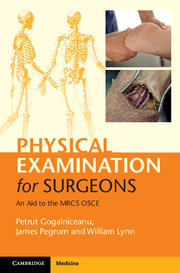Book contents
- Frontmatter
- Dedication
- Contents
- List of contributors
- Introduction
- Acknowledgments
- List of abbreviations
- Section 1 Principles of surgery
- Section 2 General surgery
- Section 3 Breast surgery
- Section 4 Pelvis and perineum
- Section 5 Orthopaedic surgery
- 14 Generic joint examination
- 15 Examination of gait
- 16 Examination of the cervical and thoracic spine
- 17 Cervical spine injury: assessment in trauma
- 18 Examination of the shoulder
- 19 Examination of the elbow
- 20 Examination of the lumbar spine and sacroiliac joint
- 21 Examination of the hip
- 22 Examination of the knee
- 23 Examination of the ankle
- Section 6 Vascular surgery
- Section 7 Heart and thorax
- Section 8 Head and neck surgery
- Section 9 Neurosurgery
- Section 10 Plastic surgery
- Section 11 Surgical radiology
- Section 12 Airway, trauma and critical care
- Index
15 - Examination of gait
from Section 5 - Orthopaedic surgery
Published online by Cambridge University Press: 05 July 2015
- Frontmatter
- Dedication
- Contents
- List of contributors
- Introduction
- Acknowledgments
- List of abbreviations
- Section 1 Principles of surgery
- Section 2 General surgery
- Section 3 Breast surgery
- Section 4 Pelvis and perineum
- Section 5 Orthopaedic surgery
- 14 Generic joint examination
- 15 Examination of gait
- 16 Examination of the cervical and thoracic spine
- 17 Cervical spine injury: assessment in trauma
- 18 Examination of the shoulder
- 19 Examination of the elbow
- 20 Examination of the lumbar spine and sacroiliac joint
- 21 Examination of the hip
- 22 Examination of the knee
- 23 Examination of the ankle
- Section 6 Vascular surgery
- Section 7 Heart and thorax
- Section 8 Head and neck surgery
- Section 9 Neurosurgery
- Section 10 Plastic surgery
- Section 11 Surgical radiology
- Section 12 Airway, trauma and critical care
- Index
Summary
Overview of the gait cycle
1. Stance phase – 60% of cycle
• Heel strike – flat foot – mid-stance – heel off – toe off
2. Swing phase – 40% of cycle
• Acceleration – mid-swing – deceleration
What is the lower limb biomechanical assessment used for?
A lower limb biomechanical assessment analyses the link between the structure, function, strengths and weaknesses of the lower limb joints and muscles. Lower limb pain can be caused or referred from a number of joints. A comprehensive examination is needed to identify the numerous contributing pathological processes, which may need to be treated concurrently with physiotherapy, orthotics, injections or surgery.
What is the difference between open and closed kinetic chains?
In open kinetic chain assessment the joint is able to move freely, either by active movement or by passive movement by the examiner. Closed kinetic chain is the assessment of gait and lower limb function whilst it is in contact with the ground.
What is the normal gait cycle?
A gait cycle is the sequence that starts with the heel strike of one foot and ends with the subsequent floor contact of the same foot. The gait is defined as a series of rhythmical and alternating movements of the trunk and lower limbs that result in forward progression of the centre of gravity.
During increasing walking speeds and running the swing phase increases and the stance phase decreases until the ratio of stance to swing phase reverses.
What are the commonly used terms?
• A step length is the distance from one heel strike to the contralateral heel strike.
• A stride length is the distance between two heel contacts of the same foot, and in a normal gait it is double the step length.
- Type
- Chapter
- Information
- Physical Examination for SurgeonsAn Aid to the MRCS OSCE, pp. 128 - 129Publisher: Cambridge University PressPrint publication year: 2015

